Contact Caravaca Tourist Office +34 968 70 24 24
or send an Email
Click Here

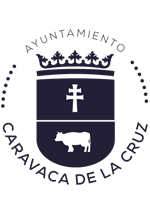

















Contact Caravaca Tourist Office +34 968 70 24 24
or send an Email
Click Here
This site uses cookies. By continuing to browse the site, you are agreeing to our use of cookies. Read More (privacy and cookie policy)


The busy May weekend offered a host of fiestas and opportunities to participate in some of the unique events 
It's a fiesta we'd first visited 9 years ago, but had wandered along as non-spanish speakers, with absolutely no idea what on earth was going on, having just been told by the man in the bank in our little town who spoke a bit of English that there was some sort of fiesta going on up the road but it wasn't really worth going to as the local fiestas in this town were actually a lot better, but we could go and have a look if we could be bothered, but of course he wouldn't be bothering himself as he had to stay at home and get ready for the much more interesting fiesta which would be taking place locally soon......
So we ambled along, wandered around in the rain, saw a few horses walking about in amazing embroidered mantles, but didn't know where to go or what to do and went home, agreeing with the man in the bank.
It wasn't until years later, that we discovered just what an astonishing fiesta was taking place in Caravaca, most of which we'd missed completely.

Their water had been contaminated and they were weak and dying of thirst. Hearing of their plight, the knights hunted for water, but could find only wine, so they tied skins of the precious liquid onto the backs of their horses, and ran them up the hill to the residents inside before the Moors besieging the castle realized what was happening. Once inside, the Holy Cross of Caravaca was bathed in the wine which miraculously healed the sick and enabled them to continue their fight and expel the invaders.
This feat of daring is commemorated in the running of the horses, who charge up the cuesta at full pelt, held by four runners, the winner completing the course in the shortest time.
There are also prizes for the best dressed horse, and the ladies of the town labour all year to create the incredible mantles worn by the horses during the race.
During the morning these are paraded around town in an informal Pasacalles, and we positioned ourselves in the 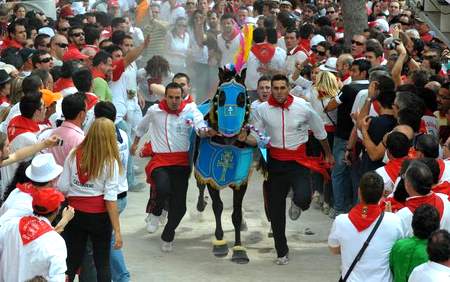
A peña is a collection of friends, who work together all year in a common cause- winning the race and having the most magnificently dressed horse and competition is fierce among the groups. Children are literally born into a peña, and its a moving sight to see babes in arms dressed in the peñas colours, proud, belonging and a member of something from the moment theyre born. Its the glue which holds Spanish society together, these peñas work all year to raise the money to fund their costumes or in this case, the embroidered coats worn by their horse, the average cost of which I was told runs to 5000 euros.
Some of these coats are heavy with real gold thread, and feature portraits of the peña members and their families. Several people posed proudly next to their own portraits, pointing out their grandchildren and parents, honoured and immortal in the exquisitely worked embroideries.
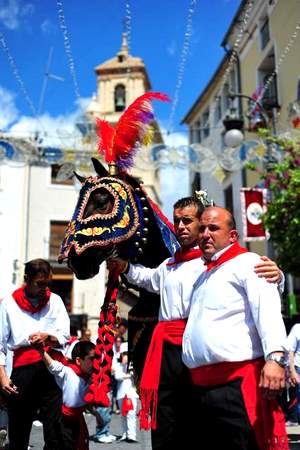
It takes all morning to parade, with the peñas following their horse around town, each accompanied by its own brass band, everyone cheering, dancing and clapping, all proudly sporting their loyalty in the form of a neck-kerchief and a t-shirt.
Following the parade, they move up to a small square and await the start of the race.
This year, Caravaca was packed to bursting, the official press blurb this morning said 200,000 had participated, the most ever, due to it being a Jubilee year, and it felt like it. It was hot and crowded on the cuesta and the ambulance was kept busy with fainting ladies falling at regular intervals, and we were relived to see many of you had come along with hats, bottles of water and strong shoes, and perched yourselves up on the rock-face out of the way.
The racing was late, and should have gone off at 2, although it didn't actually start until 3pm, much to the relief of the crowds, who were wilting badly, and the sensible moved up into the basilica or stayed down in the Plaza del Arco to watch the action on a big screen instead.
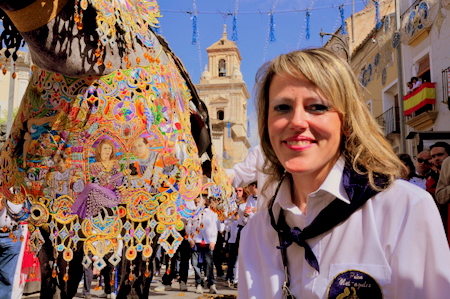
The loud speaker announces when a horse is ready to go, then the words , "Caballo en Carrera" indicates that the horse is off and running.
It's over in seconds.
Down on the ground, the young and foolhardy pack the cuesta, and as the horses run, they part to allow the horses to pass through. Its incredibly dangerous, a horse and four runners at full pelt, but these youngsters are fuelled by alcohol and bravado and they don't pull back until the last second.
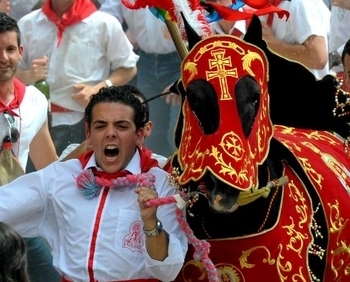
Mind you, it didnt stop him thumping the lad who'd knocked him over once he'd got over his anguish.
It's incomprehensible to think what a UK health and safety inspector would have to say about this fiesta, but the Spanish attitude is, "well if you don't want to get hurt, don't stand in the way. Have another beer and relax."
The greatest problem for photographers trying to catch the runners were the drunks, who always had to push it to the last , leaving only a split second to try and get off a shot before leaping out of the way.
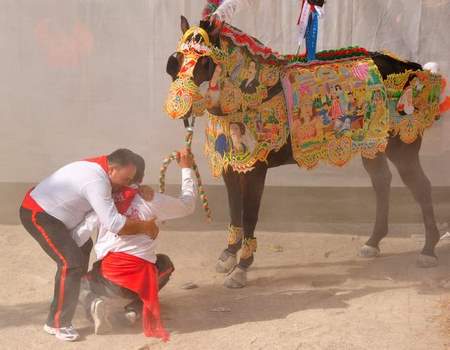
In the middle of the crowd it was almost impossible to predict the course that the horses would run, so I positioned myself right at the finish to catch them just as they decelerated, where the crowd was less dense.
The only problem with this is that I couldn't see the horses coming, so had to judge the movements and sound of the crowd to gauge when they'd break.
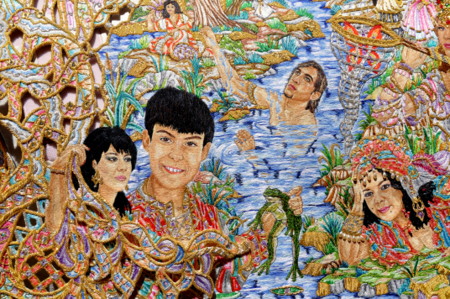
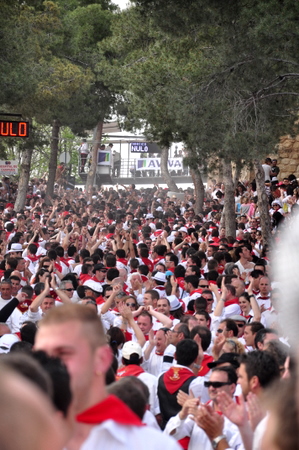
By this point the photographers on the gantry were also complaining that I was ruining their photographs, so I moved into the castle and safety.
